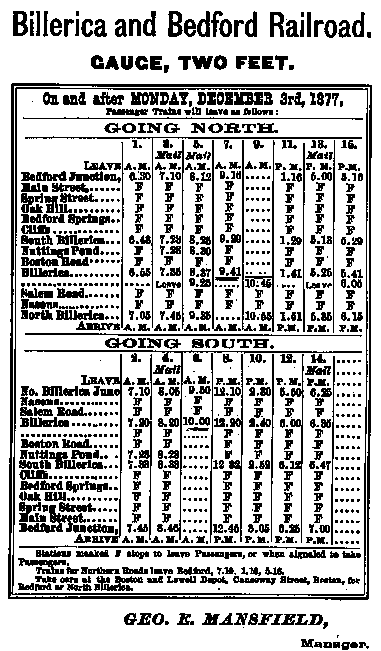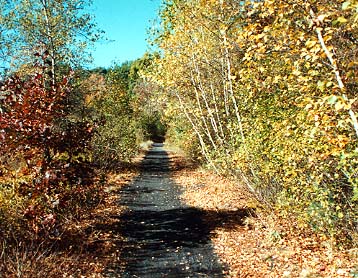Lexington Branch History | Bedford's Railroad History | Oral History Recordings | B&B Interpretive Track | Lexington Branch Study
About the Billerica & Bedford Railroad
America's First Two-Foot
Common-Carrier Railway
This overview of the Billerica & Bedford
Railroad first appeared in the October 1996 issue of "Bedford
Depot News," the newsletter of the Friends of Bedford Depot
Park.
Researched by Friends of Bedford Depot Park
August 31, 1877, was an exciting day in the towns of Billerica and Bedford, Massachusetts. People from near and far travelled to these rural communities to witness a novel engineering concept tested--one that promised to solve a local transportation problem and to do so relatively cheaply. The events of this Thursday would ultimately extend beyond local impact and have far-reaching effects throughout railroading.
Let's first set the calendar back to the 1830s, the onset of aggressive railroad building in our country. The upstart Boston & Lowell Railroad was at work, charting a route for a rail line between two important cities of commerce in the Commonwealth, Lowell and Boston. The town of Billerica laid in the path of the proposed new road--but, some inhabitants "feared and repelled" the coming of the iron horse. The B&L compromised upon a path through the town's northern outskirts, bypassing Billerica Center. (This B&L line later came into the possession of the Boston & Maine Railroad as its New Hampshire Division. It is now owned and operated by the Massachusetts Bay Transportation Authority.)
Now, let's jump ahead four decades to the mid-1870s. The Boston & Lowell Railroad's Middlesex Central subsidiary had recently extended rail service from Lexington Center to Bedford and Concord. Quickly, Bedford realized the social and economic advantages that come with direct access to modern transportation. Billericans took note of Bedford's good fortune and came to regret their earlier decision to keep the railroad out. "What to do now, though?" How could Billerica's residential, commercial and agricultural centers secure the transportation benefits which by this time were common in many other communities? That was the central question in 1875.
Enter one George E. Mansfield of Hyde Park, Massachusetts. Mr. Mansfield in 1875 was back from a trip to Wales where he observed the Festiniog Railway. This carrier used track of just 2 feet, 23-1/2 inches between the rails. (By contrast, most American railroads by this time had adopted the present standard gauge of 4 feet, 8-1/2 inches.) The Festiniog caught the fancy of Mansfield; he went on to build a small test track in his backyard to study the principles of a miniature-gauge railway. As luck would have it, around this same time he heard of Billerica's transportation dilemma and thought the narrow-gauge idea just might be the answer.
George Mansfield succeeded in convincing the authorities of Billerica that a railroad built upon a skimpy two-foot gauge was an ideal way to unite their town with the outside world. Proposed was an 8.63-mile rail line between the Boston & Lowell's station in North Billerica and the Middlesex Central's Bedford Station to the south. Mr. Mansfield's chief argument for settling upon the two-foot gauge was that it would be relatively less expensive to build and to operate than one of a conventional size. This was so because the two-footer's rail and ties are substantially smaller; less land is required for the right-of-way (just some 33 feet in width); the smaller rolling stock is cheaper to build; and the diminutive locomotives consume lesser quantities of coal.
The Hyde Park promoter also succeeded in enticing the people of Bedford with the benefits of his plan--in particular, Dr. William R. Hayden, proprietor of the renouned hotel and resort, Bedford Springs. Dr. Hayden foresaw the economic advantages of a railway that stopped at his hotel. He became a strong advocate of the plan. When a corporation was chartered in 1876 to build and operate the new line, the Billerica & Bedford Railroad, Dr. Hayden was appointed to a committee to secure investments and George Mansfield was hired as the General Manager.
The company quickly went about raising the projected $50,653 needed to build and equip the new road. The Town of Billerica subscribed to 120 shares ($12,000) in the new company. Several prominent members of the local citizenry of Bedford and Billerica also aided financially. Ground-breaking took place in South Billerica on September 6, 1876, with some 500 in attendance; but, it was at a public ceremony in Bedford on May 12, 1877, that construction formally commenced.
Just 111 days later, on August 31, the first trains were run over the line against a backdrop of enthusiasm and merrymaking. Two little Forney-type steam engines, named Ariel and Puck, pulled cars loaded with excited passengers through woods and along meadows over the newly formed right-of-way.
This historic passenger ticket from the
Billerica & Bedford Railroad was provided courtesy of the
Billerica Historical Society.
It is reproduced here at 200% of actual
size.
Those first curious riders were able to answer for themselves a
question that had earlier cast some doubt upon the narrow-gauge
concept. There were some who felt that the rolling stock used on such
a small track would "oscillate," giving riders an uncomfortable ride
or, worse, causing the cars to jump the track. To the delight of
Mansfield and his associates, however, the mechanics of their little
railway performed very well under the examination of the public and
the state's railroad commissioners.
Over the next few months, work to complete the B&B progressed. Turntables to reverse the locomotives were established at Billerica and North Billerica. A wye, a car shed and an engine house were built at the Bedford terminus. Though it has been moved from its original location, the B&B Engine House has survived into the 1990s and is today rented out as a bakery on South Road.
Construction cost overruns caused the company to become short on cash in the autumn of 1877. When all was said and done, the road's total price had risen to some $71,000. To add insult to injury, certain of the stock subscriptions turned out to be unsound--Mansfield himself was on the list of delinquent shareholders. The B&B found itself strapped for cash. On at least one occasion, the railroad had difficulty in meeting the payroll of its construction workers. A labor stoppage resulted, temporarily, until management came up with the demanded money.
The scarcity of capital also precluded the erecting of depots at any of the 11 stations between the termini. It seems that the trains simply stopped at marked locations along the route to discharge and receive passengers.
Full timetable service on the Billerica & Bedford commenced on Thanksgiving Day of 1877. The printed schedule called for seven passenger, mail and freight trains each way daily. Trains were run even on Sundays, in conflict with criticism from some locals who believed that their Holy Day should be without the clank and hiss of the steam locomotive.

This only known surviving copy of the B&B's 1877 timetable resides in the archives of the Billerica
Historical Society.
For several months, the unassuming towns of Bedford and Billerica
played host to professional engineers, businessmen, journalists and
visitors from around the country and across the Atlantic who came to
study the unusual two foot enterprise. All accounts are that they
were quite favorably impressed. A prominent national publication of
that time, "The Railroad Gazette," and one that is still with us
today, "Scientific American," each published detailed technical
accounts of the B&B.
It was recorded that the railroad's daily profits exceeded operating expenses. Only nine passengers at the 25-cent one-way fare were required to pay for labor and fuel out-of-pocket costs of only $1.12 per trip. Against these positive figures, however, stood the under capitalization of the corporation and cost overruns. By early 1878 the company was placed into bankruptcy when creditors demanded their payments on a quicker schedule than the railroad could afford.
For several months the B&B continued to operate while attempts were made to resolve the financial crises. Ultimately, the corporation's assignees decided to liquidate the corporations's assets in order to pay its bills. On Thursday, June 6, an auction was held at the railroad's Engine House in Bedford. The successful bidder for the locomotives and cars was a Mr. Brown of New Hampshire. The price: just $9,000.
In early 1879, a new company was chartered to buy back the narrow-gauge equipment and reopen the line. The charter called for a capital investment of $20,000, with the Town of Billerica taking $10,000, the Town of Bedford, $2,000, and the other $8,000 to be raised by individual subscription. At two Bedford Town Meeting sessions, a majority of votes were counted in favor of funding the initiative--but not the two-thirds majority as required by law. When the article came up a third and last time, the results were less favorable: a majority of 23 votes were against the measure.
The Billerica & Bedford's final flicker of hope had been extinguished--but this was not so for the two-foot gauge concept itself. That was proven a success.
Even before the B&B trains made their last runs, the citizens of Farmington, Maine, were contemplating a local railroad of their own. Hearing word of this, Mansfield travelled north and promoted the two-foot idea there to anyone who would listen, just as he had done earlier in Billerica and Bedford. It may have been no coincidence, then, that after final efforts to save the B&B failed, the new Sandy River Railroad found a great bargain in buying the rolling stock and track of the now-defunct Massachusetts two-footer.
George Mansfield transplanted himself to the Farmington area along with the locomotives and cars from Bedford. He was made General Manager of the Sandy River, the same position he held with the B&B.
Once in the woods of Maine, the two B&B steam locomotives were converted to burn the abundant fuel source of their new surroundings, wood. The Sandy River Railroad went on to flourish for decades and even spawned other two-footers in the region. When the railroad ceased operating in the 1930s, it was purchased by the owner of a cranberry farm in South Carver, Massachusetts, and transported there. Not long afterward, Edaville Railroad was opened to the general public as an attraction and has since given generations a chance to experience firsthand an authentic two-foot railway.
The Boston & Lowell Railroad
ultimately provided the local transit service that the two-foot line
had set out to do. On May 1, 1885, the B&L opened a
standard-gauge extension of its Lexington
Branch over the former
B&B roadbed. This line remained in service until 1962.

Above is a photo of the B&B's right-of-way approaching South Billerica.
The section of the old route in Bedford is today the Narrow-Gauge Rail-Trail.
Click here to read about the Billerica & Bedford Railroad interpretive track.
Watch a video that shows how we commemorated the 125th anniversary of the B&B in September 2002.
Join FBDP and read more about the unique history of the B&B in the organization's newsletter.